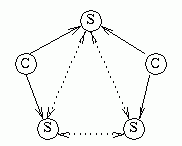Time Clerk
The time clerk is the client side of DTS. It runs on a client machine, such as a workstation, and keeps the machine's local time synchronized by asking time servers for the correct time and adjusting the local time accordingly.
The time clerk is configured to know the limit of the local system's hardware clock. When enough time has passed that the system's time is above a certain inaccuracy threshold (that is, the clock may have drifted far enough away from the correct time), the time clerk issues a synchronization. It queries various time servers for their opinion of the correct time of day, calculates the probable correct time and its inaccuracy based on the answers it receives, and updates the local system's time.
The update can be gradual or abrupt. If an abrupt update is made, the software register holding the current time is modified to reflect the new time. Usually, however, it is desirable to update the clock gradually, and in this case the tick increment is modified until the correct time is reached. In other words, if a clock is normally incremented 10 milliseconds at each clock interrupt, and the clock is behind, then the clock register will instead be incremented 11 milliseconds at each clock tick until it catches up.
The following figure shows a LAN with two time clerks (C) and three time servers (S). Each of the time clerks queries two of the time servers when synchronizing. The time servers all query each other.
DTS Time Clerks and Servers
